The solar micro inverter market is estimated to be valued at US$ 38.54 Bn in 2025 and is expected to reach US$ 137.37 Bn by 2032, growing at a compound annual growth rate (CAGR) of 19.9% from 2025 to 2032.
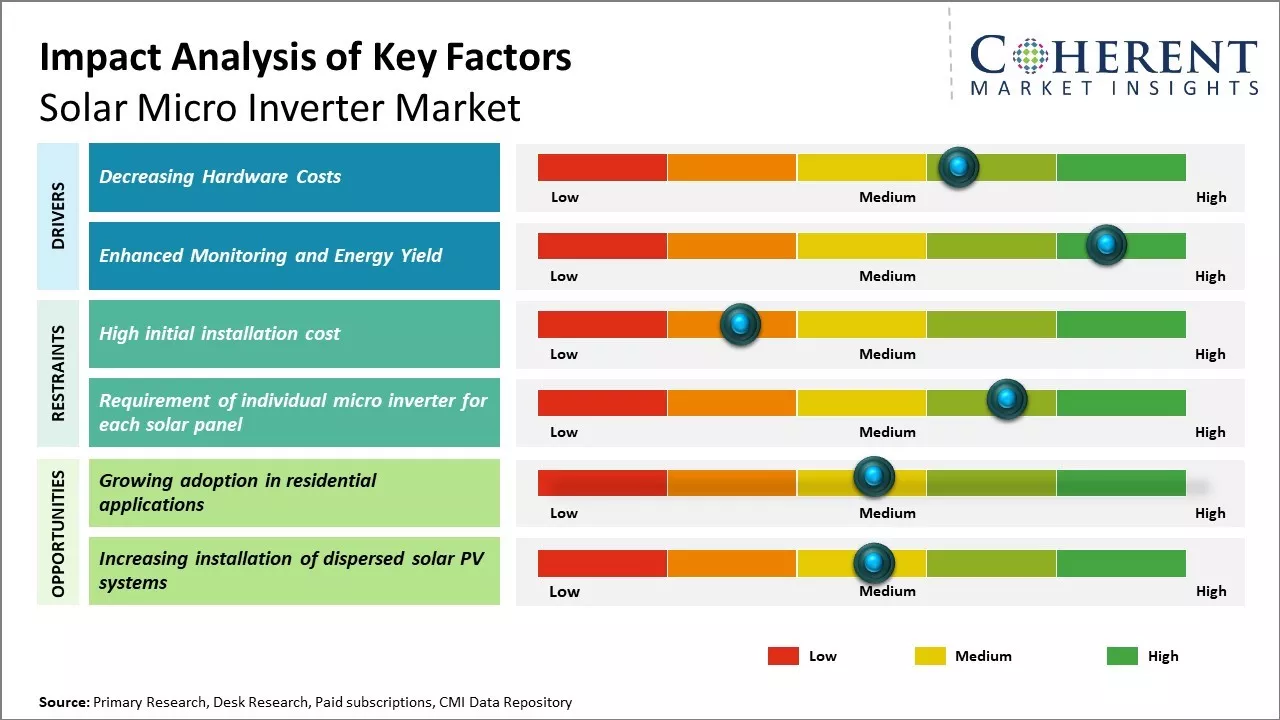
Discover market dynamics shaping the industry: Request sample copy
Micro inverters allow the optimal performance of each solar module individually to boost the overall system efficiency. Their use has increased the adoption of solar energy across the residential and commercial sectors. The solar micro inverter market is expected to witness significant growth over the forecast period. Stringent regulations regarding carbon emission reduction and growing emphasis on renewable sources of energy are expected to drive the demand for solar micro inverter. Moreover, the trend towards decentralized and distributed solar generation coupled with technical benefits of micro inverters such as module level monitoring, optimal energy harvesting, and ease of maintenance are anticipated to provide opportunities for market growth during the forecast period.
Solar Micro Inverter Market Drivers:
Decreasing Hardware Costs
The costs associated with the hardware components used in solar micro inverters has witnessed a significant decrease in the past few years. Manufacturers have been able to achieve substantial economies of scale due to the rising demand for solar PV installations across both the residential and commercial sectors globally. This has enabled them to invest heavily in research and development activities to make the micro inverters more efficient using less material and lowering manufacturing costs. The semiconductor chips and Integrated Circuits (ICs) used in micro inverters occupy much smaller real estate compared to traditional string inverters, translating to lower bill of material costs. Moreover, innovations in power conversion design have increased power densities manifold, further bringing down hardware costs.
Integration of newer high-efficiency power switching devices like silicon carbide metal oxide semiconductor field effect transistor MOSFETs and Insulated-Gate Bipolar Transistor IGBTs along with advanced gate driver modules have maximized power outputs. This has allowed manufacturers to reduce the number of components needed in each unit to deliver the same power capacity. With steady reduction in pricing achieved over the past few years, micro inverters have become much more affordable for solar installers and homeowners. The payback period has shortened significantly, making them an attractive proposition even in price-sensitive emerging solar markets. Additionally, localized manufacturing especially in China and Southeast Asia has ensured greater supply assurance and economies of scale benefits are passed on the end customers. Overall, plummeting hardware costs is a major driver increasing the competitiveness of solar micro inverters against traditional string inverters.
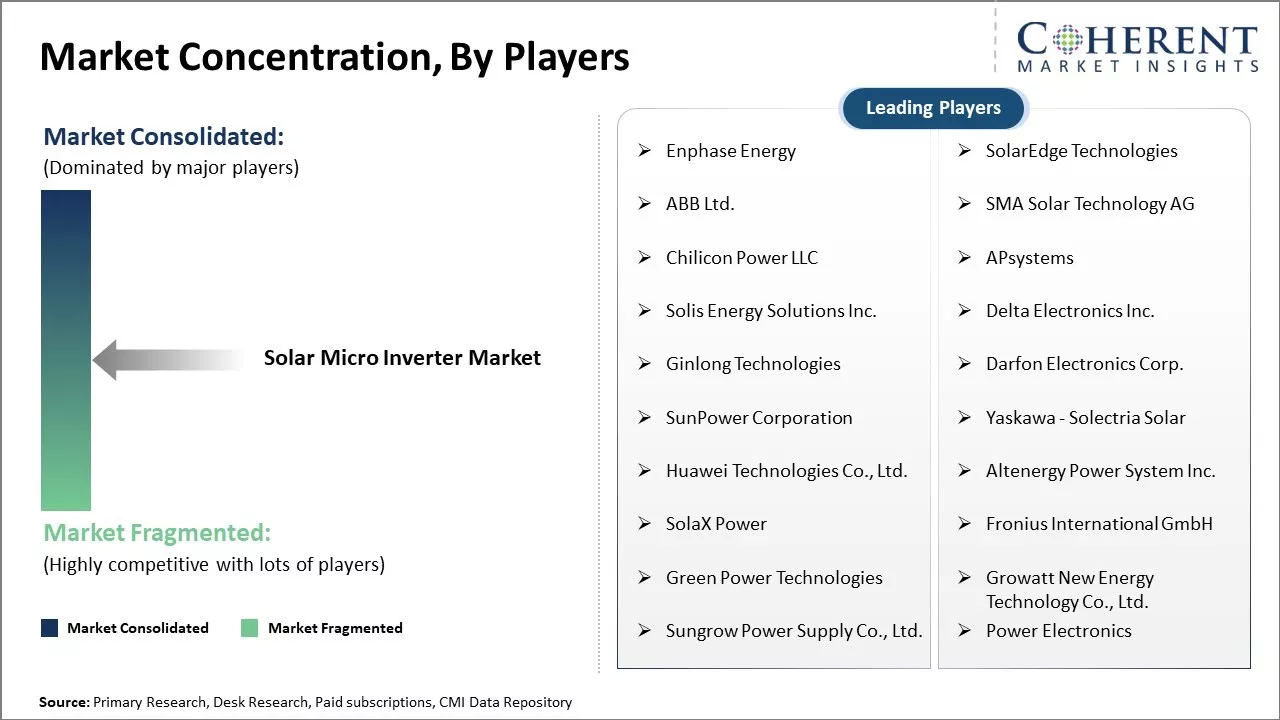
Get actionable strategies to beat competition: Request sample copy
Enhanced Monitoring and Energy YieldOne of the key advantages of solar micro inverters lies in their ability to maximize energy harvest from each solar PV module individually. Traditional string or central inverters have limitations that portions of strings experiencing shade or underperformance are unable to contribute their full potential. However, micro inverters solve this issue elegantly as they monitor and optimize power conversion for every single solar panel separately. This allows much higher solar energy utilization even in installations where partial shade is unavoidable such as rooftop systems. Advanced monitoring features integrated into newer micro inverter models have added to this value proposition. Homeowners and commercial building managers can keep a tab on performance of each solar module remotely via mobile or web-based dashboards.
Real-time production data collated module-wise helps in proactively detecting faults and underperforming panels. System administrators can locate issues promptly and schedule maintenance well in advance to prevent losses.
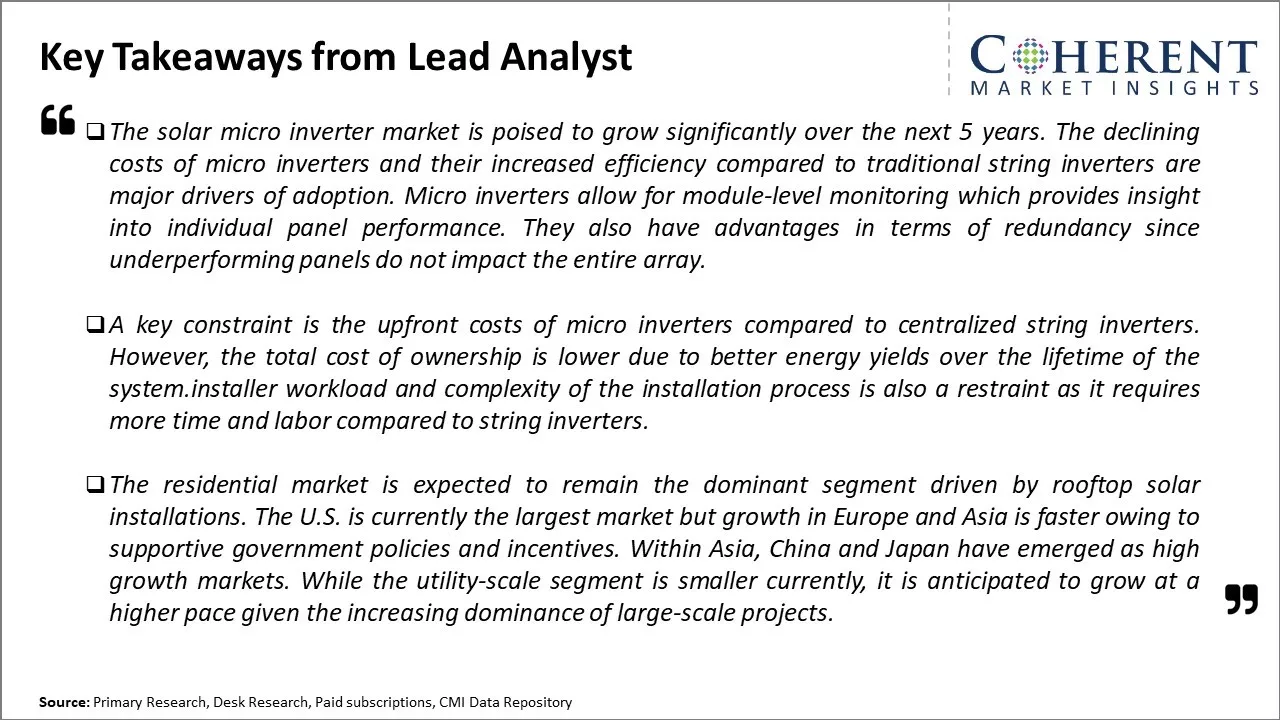
To learn more about this report, Request sample copy
Solar Micro Inverter Market Challenges:The solar micro inverter market faces several challenges. Established solar panel manufacturers have existing infrastructure optimized for central or string inverters, incurring costs to transition production. Micro inverters also require multiple power optimizers which drive up costs. Consumers may hesitate to adopt micro inverters due to higher upfront expenses compared to string inverters. Installers need to be thoroughly trained on proper micro inverter installation and maintenance best practices. Ensuring maximum performance and reliability over the 25 year lifespan of a solar installation adds to the complexity and may reduce consumer confidence.
Solar Micro Inverter Market Opportunities:
However, the solar micro inverter market also presents several opportunities. Micro inverters can harvest up to 30% more energy from each solar panel compared to string inverters. This improves returns on investment.
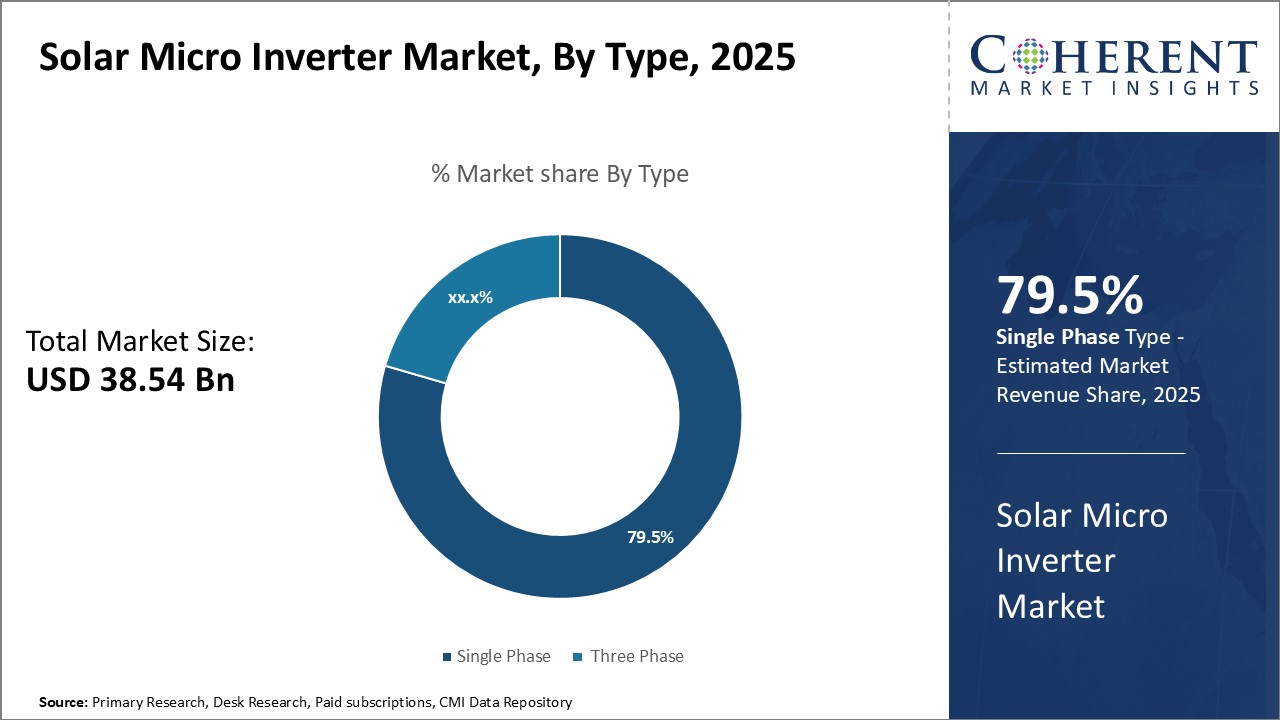
Discover high revenue pocket segments and roadmap to it: Request sample copy
Insights By Type - Convenience and Cost-effectiveness Drive Growth of Single Phase Micro InvertersThe single phase segment contributes the highest share of 79.5% in 2025 to the solar micro inverter market owing to its convenience and cost-effectiveness. As most residential solar systems use single phase electricity, these micro inverters are well-suited for homeowners looking to install rooftop panels. They have simple installations that do not require expensive rewiring of electrical panels. Homeowners receive a plug-and-play solution without much hassle.
Single phase micro inverters are also very cost-effective compared to larger multi-phase systems. They are much smaller and cheaper to manufacture while still delivering optimal power harvesting capabilities on a per panel basis. For solar installers, single phase micro inverters mean lower equipment and labor costs when deploying systems on residential rooftops. Their distributed architecture also enhances design flexibility to fully utilize available roof space.
With rising solar adoption among households, the single phase segment is expected to further cement its leading position. As technology improves energy yields and lifetimes increase, these micro inverters will see strong demand for their user-friendly and affordable attributes. Their decentralized approach that works with any roof layout also makes them very appealing for residential prosumers.
Insights By, Offering- Hardware Dominates Offerings within Micro Inverters
The hardware component contributes the highest share of 45.5% in 2025 among different micro inverter offerings due to being the core technological component that converts direct current from solar panels into alternating current usable by homes. These inverters are sophisticated electrical devices equipped with power transistors, switching components, capacitors and cooling mechanisms. They require precision engineering to reliably handle high voltage DC electricity from panels.
Despite software and service opportunities emerging, hardware revenues will remain robust given micro inverters' capital-intensive nature. Periodic hardware replacements will also boost sales over time. Manufacturers continue making hardware advances such as boosting power density within compact footprints, increasing energy yields, improving maximum power point tracking, and extending operational lifetimes above 25 years. These innovations attract more homeowners and keep hardware dominant within micro inverter offerings.
As hardware brings critical capacity and performance advantages over older technologies, suppliers prioritize new product development, and custom engineering support here. Robust hardware sales therefore drive reinvestments and further progress for the entire micro inverter industry.
Insights By, Power Rating- Higher Power Ratings Expand System Deployments
Within micro inverter power ratings, the above 500W segment contributes the highest share of 39.5% in 2025 owing to more opportunities in commercial and multi-megawatt utility scale applications. Micro inverters with power outputs above 500W can efficiently handle larger 300-400W solar panels commonly used in non-residential projects. Their scalability alleviates earlier constraints and allows harnessing higher voltages compatible with broader system sizes.
Larger power capacities boost the technical potential for micro inverters. System integrators are adopting above 500W models to design solar Photo Voltaic PV plants rated over 1MW. Their modular flexibility streamlines assembly across vast commercial rooftops and ground mounts. Manufacturers also customize these high-power micro inverters suited for specialized uses like solar carports and solar trees.
As renewable energy portfolios of utilities expand, harnessing high power micro inverters becomes attractive to maximize returns from large vacant lands. Several pilot projects tie micros above 500W capacity with energy storage to evaluate performance managing intermittent solar generation. Such innovative deployments lay the foundation for broader grid services and renewables integration going forward. Overall, their greater scaling ability drives higher adoption within growing utility applications.
Insights By, Application, Residential contributes the highest share of the market owing to increasing solar rooftop installations
The residential segment has remained the largest application area for solar micro inverters over the past few years with 62.5% market share in 2025 owing to a rising number of homeowners opting for rooftop solar installations. Solar micro inverters are commonly used in residential solar photovoltaic systems as they offer several benefits over traditional string inverters. Micro inverters work efficiently on a module level, maximizing the energy harvest of each solar panel. This helps homeowners derive optimal power output from their solar arrays throughout the day, even if some panels are partially shaded. Additionally, micro inverters enhance solar panel level monitoring. Homeowners can monitor the performance of individual panels from their smartphones using plant monitoring apps. This level of module-level monitoring has helped address underlying issues and boost overall system efficiency for residential consumers.
The trend of residential solar installations is gaining momentum globally due to favorable net metering policies and subsidies offered by governments. An increasing number of households are investing in rooftop panels to reduce their electricity bills as well as contribute to clean energy generation. In certain regions, new residential buildings are even mandated to install a minimum solar capacity. This growing emphasis on distributed solar energy at the residential level has fueled the adoption of micro inverters to optimize module performance. As more homeowners look to harvest solar power through rooftop panels, the residential category is expected to sustain its lead in the solar micro inverter market over the coming years.
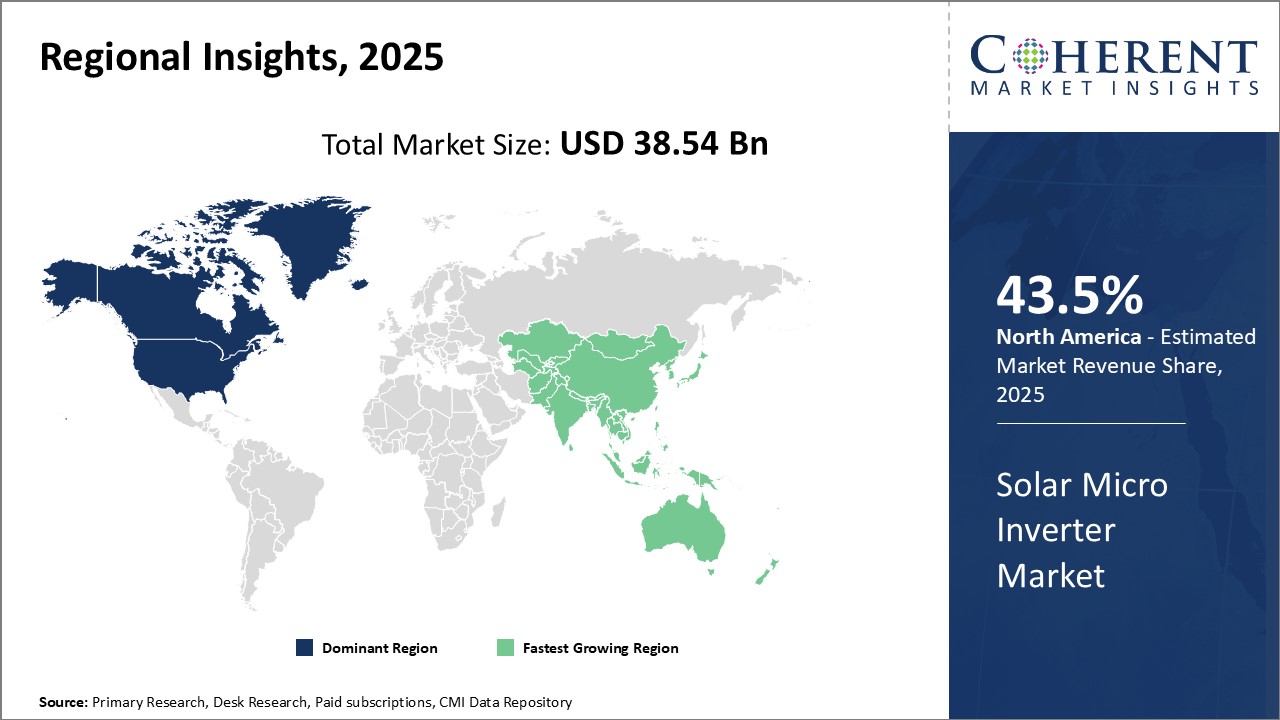
Need a Different Region or Segment? Customize now
The North America has firmly established itself as the dominant region in the global solar micro inverter market with 43.5% market share in 2025. The country has a well-developed solar energy sector backed by supportive government policies and incentive programs over the past decade. It has attracted significant investment from private players to ramp up domestic manufacturing capacities. Major solar micro inverter manufacturers like Enphase Energy, SolarEdge, and Altenergy Power Systems have their headquarters and primary manufacturing facilities located in the U.S. This has made the U.S a cost-competitive hub for solar micro inverters.
Moreover, the uptake of solar energy has been the strongest in states like California, Arizona, and Texas which have ideal climatic conditions for solar generation throughout the year. Commercial and residential solar installations in these sunny regions have steadily increased the demand for micro inverters. Contractors and installers in the U.S. also have greater experience and familiarity using micro inverters. This familiarity combined with locally available technical support has boosted consumer confidence in micro inverter technology compared to other markets.
The Asia Pacific region has emerged as the fastest growing market for solar micro inverters globally over the past five years. China represents the largest market within the Asia Pacific region led by its rapid expansion of rooftop solar installations across the country. Several Chinese solar panel manufacturers like JinkoSolar, Trina Solar, and Canadian Solar have recently entered the micro inverter business to offer an integrated solar energy solution. They have made large investments in micro inverter production to meet the growing domestic demand and also expand exports within Asia Pacific and to other regions.
Countries like India, Japan, South Korea, and Australia have also shown considerable growth potential for micro inverters. In India, policies promoting solar rooftop installations coupled with frequent power outages have persuaded homeowners as well as commercial establishments to install solar panels along with micro inverters. This strong policy push and increasing adoption of solar energy at the distributed level have contributed to the Asia Pacific region emerging as a fast growing solar micro inverters market.
Solar Micro Inverter Market Report Coverage
| Report Coverage | Details | ||
|---|---|---|---|
| Base Year: | 2024 | Market Size in 2025: | USD 38.54 Bn |
| Historical Data for: | 2020 To 2024 | Forecast Period: | 2025 To 2032 |
| Forecast Period 2025 to 2032 CAGR: | 19.9% | 2032 Value Projection: | USD 137.37 Bn |
| Geographies covered: |
|
||
| Segments covered: |
|
||
| Companies covered: |
Enphase Energy , SolarEdge Technologies , ABB Ltd. , SMA Solar Technology AG , Chilicon Power LLC , APsystems , Solis Energy Solutions Inc. , Delta Electronics Inc. , Ginlong Technologies , Darfon Electronics Corp. , SunPower Corporation , Yaskawa - Solectria Solar , Huawei Technologies Co., Ltd. , Altenergy Power System Inc. , SolaX Power , Fronius International GmbH , Green Power Technologies , Growatt New Energy Technology Co., Ltd. , Sungrow Power Supply Co., Ltd. , and Power Electronics |
||
| Growth Drivers: |
|
||
| Restraints & Challenges: |
|
||
Uncover macros and micros vetted on 75+ parameters: Get instant access to report
*Definition: The solar micro inverter market consists of micro inverters that are used in solar photovoltaic systems, allowing each individual solar panel to be connected to an inverter to convert the direct current (DC) power generated into alternative current (AC) power that can be used in homes and businesses or fed into the electrical grid. Micro inverters maximize solar power harvesting by enabling underperforming panels to be bypassed, reducing equipment costs, and installation complexities compared to traditional string.
Share
Share
About Author
As an accomplished Senior Consultant with 7+ years of experience, Pooja Tayade has a proven track record in devising and implementing data and strategy consulting across various industries. She specializes in market research, competitive analysis, primary insights, and market estimation. She excels in strategic advisory, delivering data-driven insights to help clients navigate market complexities, optimize entry strategies, and achieve sustainable growth.
Missing comfort of reading report in your local language? Find your preferred language :
Transform your Strategy with Exclusive Trending Reports :
Frequently Asked Questions
Joining thousands of companies around the world committed to making the Excellent Business Solutions.
View All Our Clients
US Reciprocal Tax Impact Analysis On Solar Micro Inverter Market
Stay updated on tariff changes with expert insights and timely information